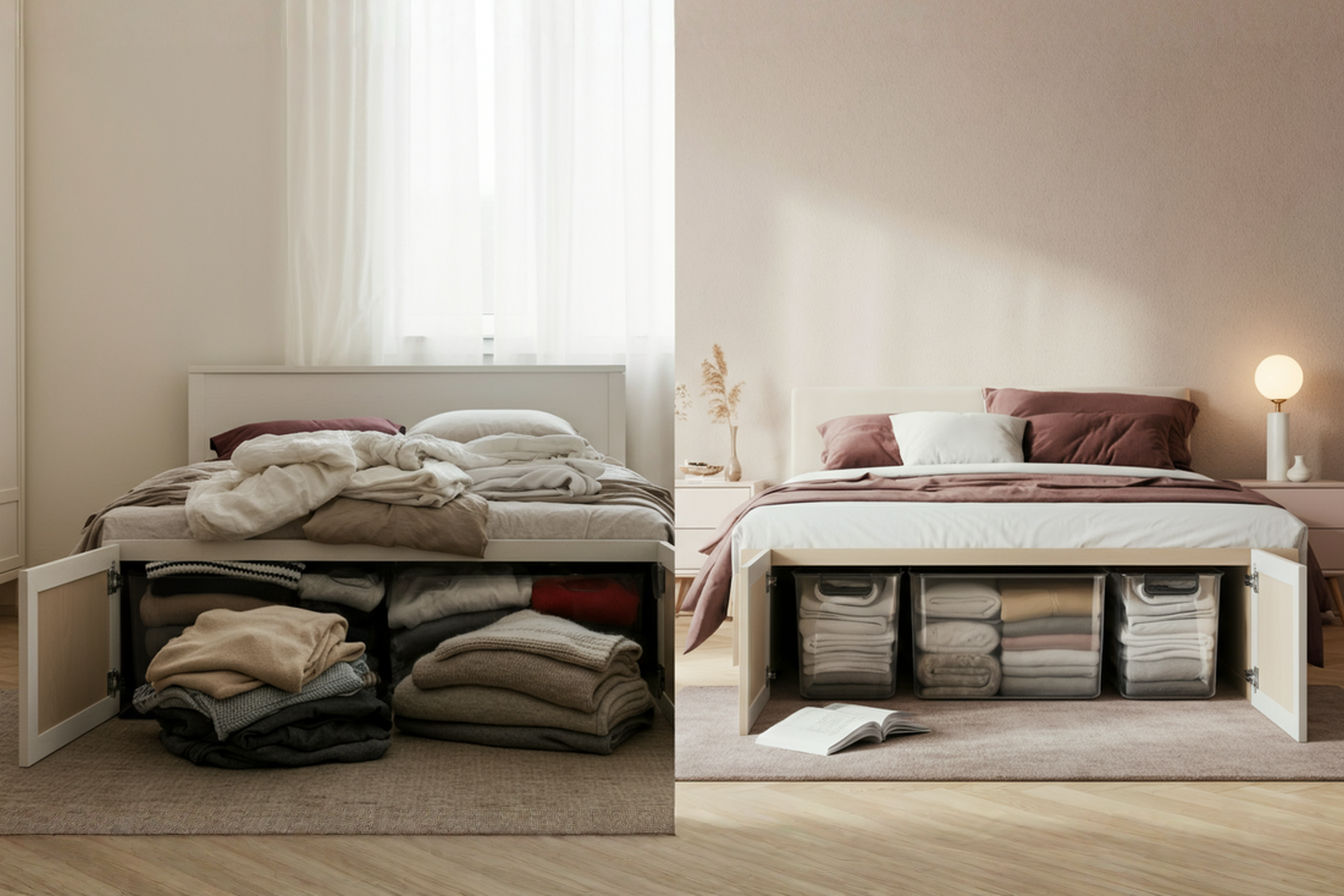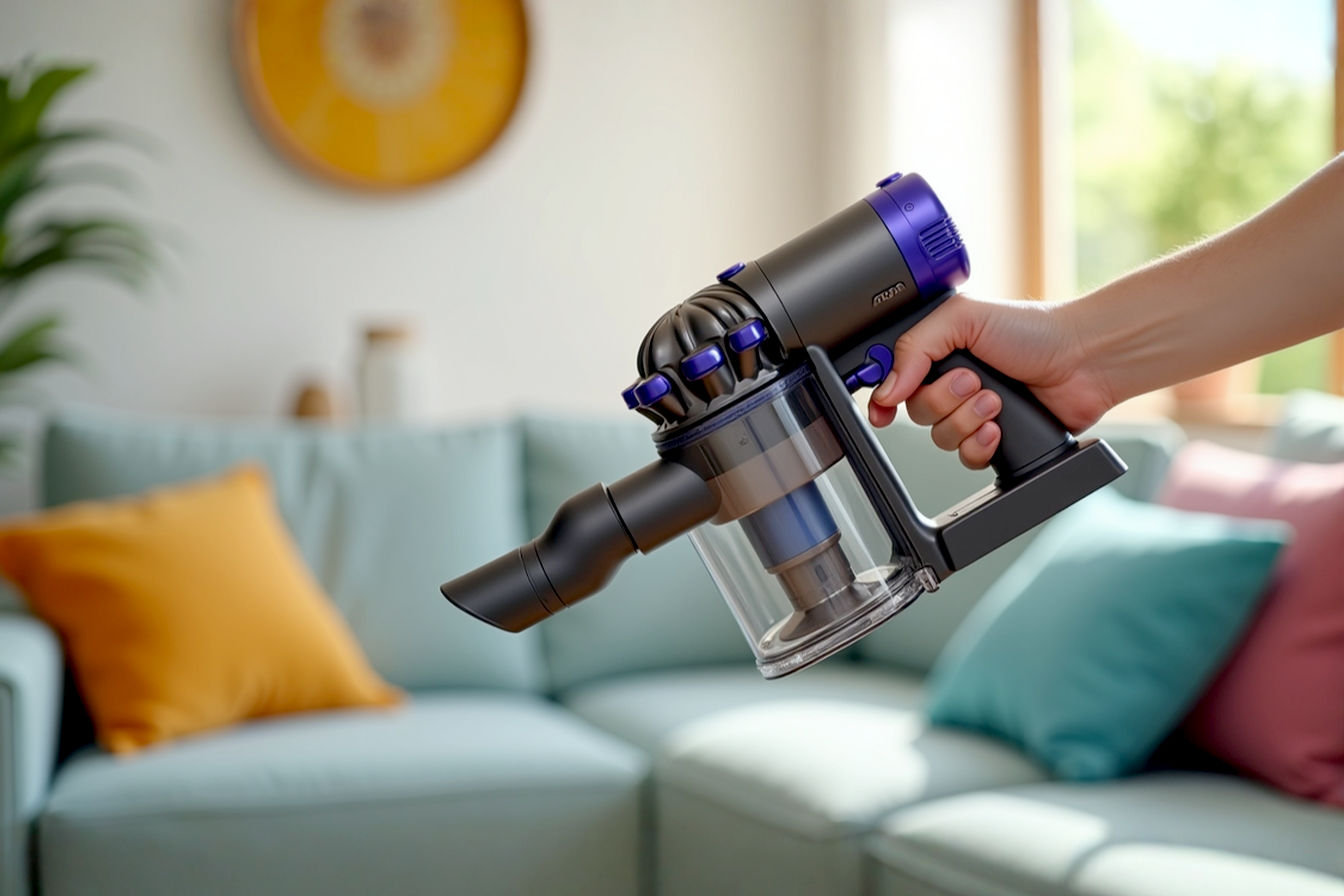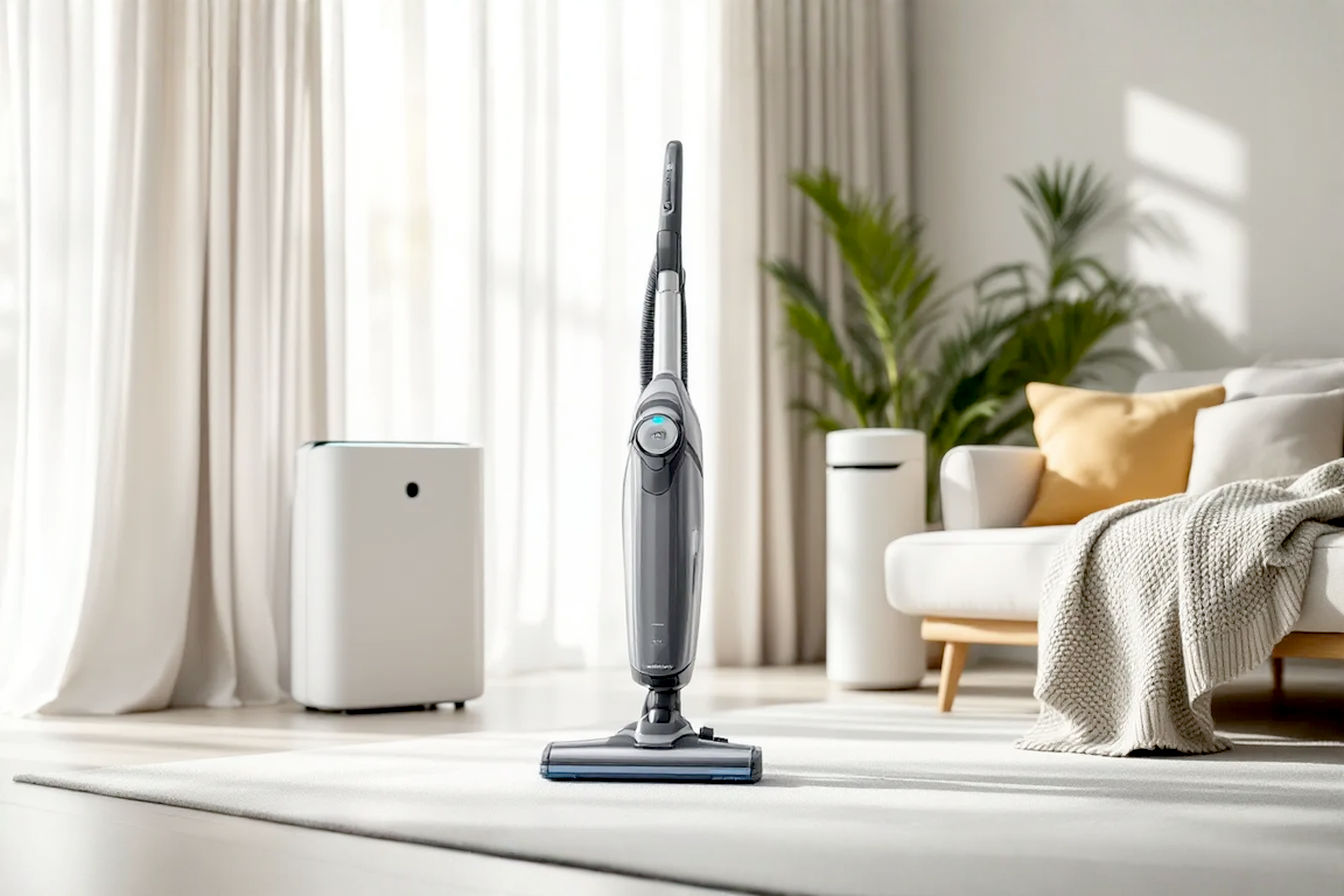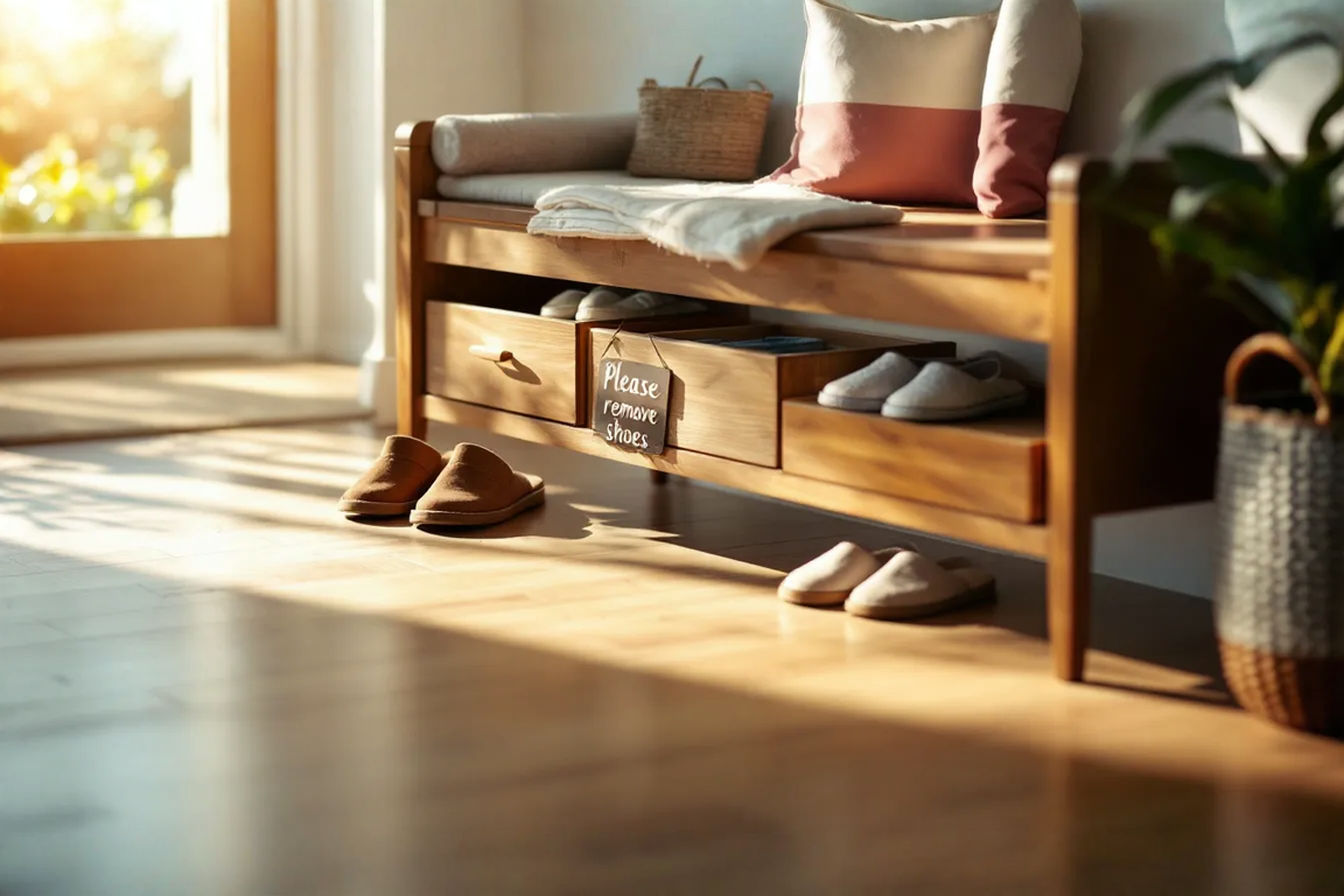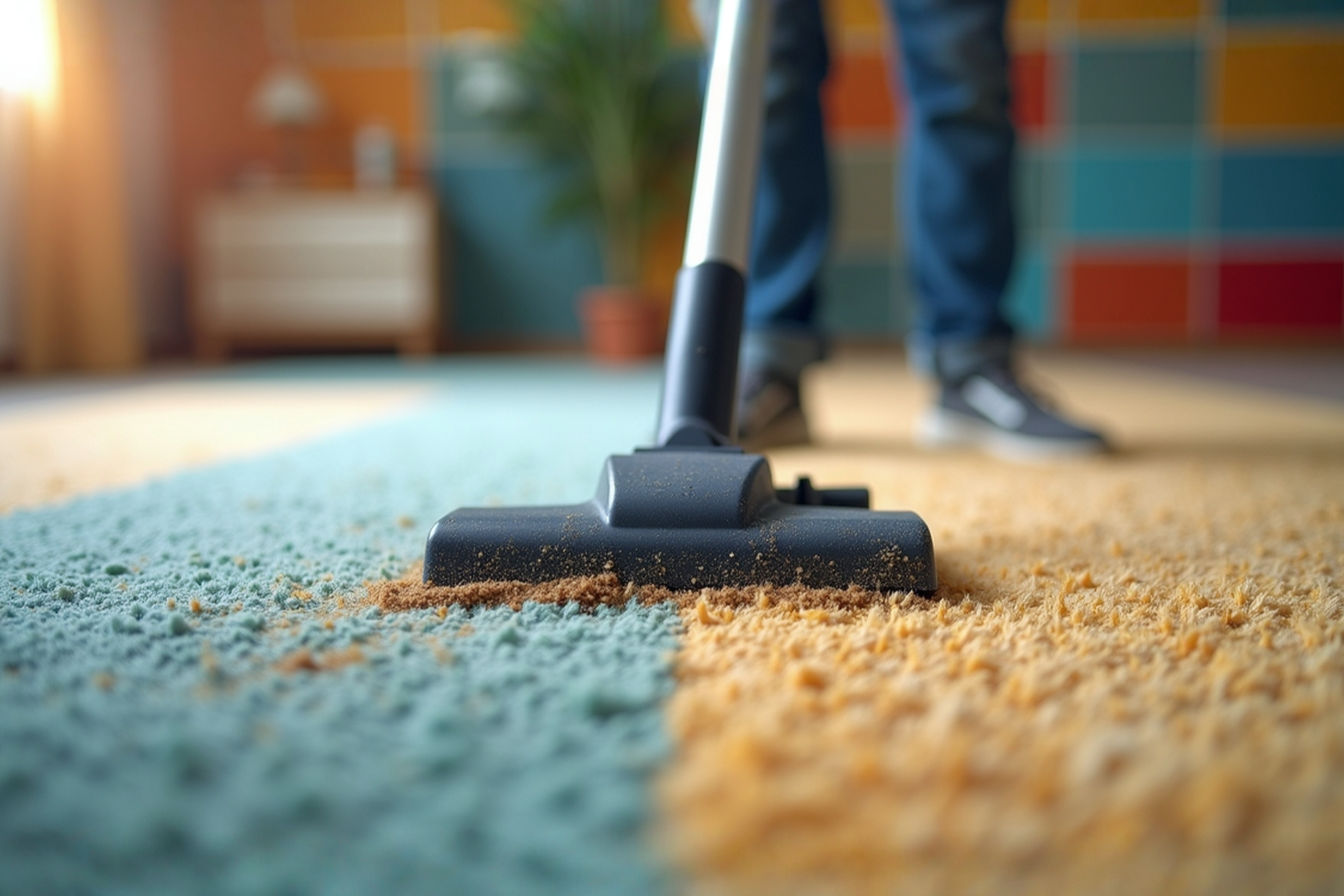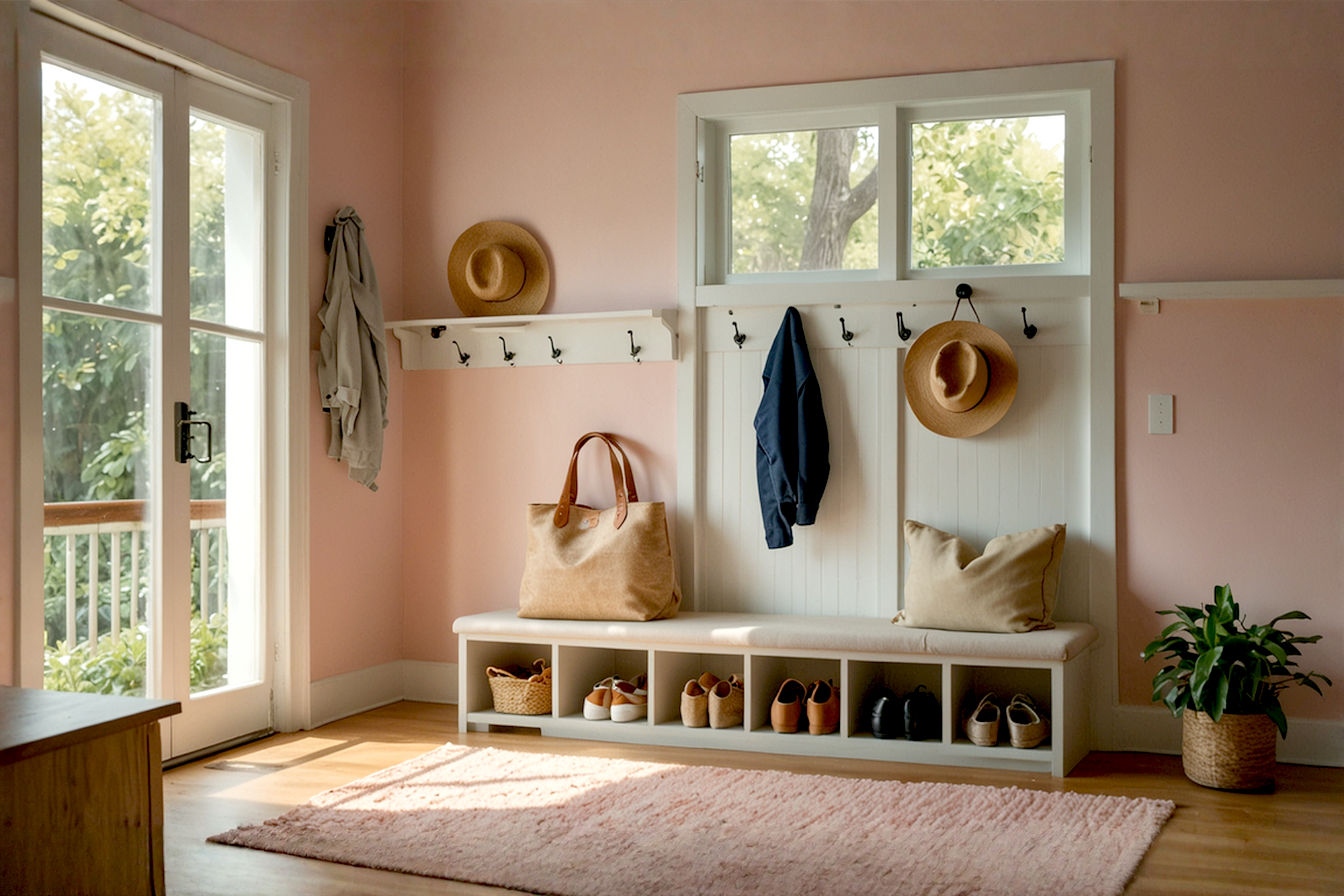Visual Overstimulation Prevention: Vacuum Storage That Reduces Visual Clutter
Visual clutter overwhelms your brain and increases stress. Learn how vacuum storage technology can help you create visually calm environments without sacrificing the possessions you need and love.
This post may contain affiliate links. If you make a purchase through these links, we may earn a commission at no additional cost to you.
Visual overstimulation occurs when our brains become overwhelmed by excessive visual input from our surroundings. In today’s world of constant visual stimuli—from cluttered homes to digital screens—many people experience the negative effects of visual overload without realizing it. This overstimulation can manifest as anxiety, irritability, difficulty concentrating, and even physical symptoms like headaches or eye strain.
Living in visually cluttered environments takes a toll on our mental wellbeing. Each item in our visual field requires mental processing, even if we’re not consciously focusing on it. The more items competing for attention, the greater the cognitive burden. This continuous processing drains mental energy and can lead to stress, overwhelm, and decreased productivity.
Vacuum storage presents a practical solution to this modern problem. By dramatically reducing the physical footprint of many household items, vacuum storage solutions help create visually calm environments without requiring extreme minimalism or discarding cherished possessions.
This approach particularly benefits:
- People with sensory processing sensitivities
- Individuals with ADHD or autism spectrum conditions
- Those living in small spaces
- Anyone seeking mental clarity and reduced environmental stress
- Families managing seasonal items and children’s belongings
By understanding how visual information affects our brains and implementing strategic storage solutions, we can create spaces that support rather than strain our cognitive resources.
Understanding Visual Overstimulation
The Science Behind Visual Processing
Our brains continuously process visual information through a complex system that begins with light entering our eyes and ends with cognitive interpretation. This system evolved primarily for survival in natural environments—not for the visually dense settings of modern life.
When we see something, our brains must:
- Register the visual stimulus
- Filter relevant from irrelevant information
- Process the meaning and importance
- Decide whether a response is needed
This happens unconsciously thousands of times per day. In visually cluttered environments, this system works overtime, leading to what neuroscientists call “attentional fatigue”—the mental exhaustion that comes from constant filtering and processing.
Signs and Symptoms of Visual Overstimulation
Visual overstimulation doesn’t affect everyone equally, but common symptoms include:
- Feeling overwhelmed when entering cluttered spaces
- Difficulty focusing on tasks in visually busy environments
- Increased irritability after spending time in cluttered areas
- Mental fatigue that seems disproportionate to your activities
- Avoidance of certain environments or spaces in your home
- Relief when entering visually minimal spaces
For neurodivergent individuals, these symptoms may be more intense and disruptive to daily functioning.
Modern Living and Increased Visual Stimuli
Today’s living environments contain unprecedented levels of visual information:
The average American home contains over 300,000 items, according to professional organizers. Even if most are stored away, many remain visible in our daily environments. Add to this the visual input from digital devices, advertising, and urban environments, and our visual processing systems face constant demand.
Modern interior design trends often emphasize open shelving, gallery walls, and visible storage—aesthetic choices that increase visual density. While visually interesting, these design approaches can contribute to cognitive overload.
Groups Particularly Affected
While everyone experiences visual overload to some degree, certain groups are especially vulnerable:
Neurodivergent individuals, particularly those with autism spectrum conditions or ADHD, often have differences in sensory processing that make them more susceptible to visual overstimulation. Their brains may not filter unimportant visual information as efficiently, making every item in view demand attention.
Highly sensitive people (HSPs) process sensory information more deeply than average. An estimated 15-20% of the population falls into this category, experiencing stronger reactions to all types of stimuli, including visual input.
Children, whose developing brains are still learning to filter information, can be particularly affected by visual clutter, potentially impacting concentration, behavior, and learning.
The Connection Between Visual Clutter and Mental Health
Research on Clutter and Stress Levels
The link between visual clutter and psychological well-being is well-established in research:
A 2010 study published in the Journal of Personality and Social Psychology found that women who described their homes as cluttered had higher levels of cortisol (the stress hormone) than those who described their homes as restful and restorative.
Research from Princeton University’s Neuroscience Institute revealed that physical clutter in your environment competes for attention, resulting in decreased performance and increased stress. Their studies showed that visual clutter literally limits your brain’s ability to process information effectively.
Cognitive Load Theory and Visual Environments
Cognitive load theory helps explain why cluttered environments affect us. This theory suggests our working memory (the mental workspace we use for active thinking) has limited capacity. Every item in our visual field that requires attention—even unconscious attention—takes up valuable cognitive resources.
In cluttered environments, a significant portion of our cognitive capacity gets redirected to processing, filtering, and ignoring visual information, leaving less mental bandwidth for important tasks, creative thinking, or relaxation.
Dr. Sabine Kastner, professor of neuroscience at Princeton University, explains: “Multiple objects in the visual field compete for neural representation because of the limited processing capacity of the visual system.”
Impact on Focus, Productivity, and Relaxation
The cognitive consequences of visual clutter include:
- Decreased focus – Research shows that people working in cluttered environments make more errors and take longer to complete tasks
- Reduced productivity – A survey by OfficeMax found that 77% of respondents believed clutter damaged their productivity
- Compromised relaxation – Visual clutter can make it difficult for spaces to feel restful, affecting sleep and downtime quality
- Decision fatigue – Constantly deciding what to look at and what to ignore depletes mental energy
The Psychological Benefits of Organized Spaces
Conversely, visually organized environments offer significant benefits:
Studies from the University of California show that organized, visually calm environments tend to promote healthier choices, better focus, and more generous behavior. Participants in organized rooms were more likely to choose healthy snacks, donate to charity, and make conventional choices.
Organized spaces also support what psychologists call “mental clarity”—the ability to think without interference from competing stimuli. This mental state facilitates better decision-making, creative thinking, and emotional regulation.
Introduction to Vacuum Storage Technology
What is Vacuum Storage?
Vacuum storage is a method of compressing items by removing air from specialized containers or bags, dramatically reducing their volume while protecting their contents. This technology creates airtight seals that not only save space but also protect contents from moisture, dust, and pests.
Unlike conventional storage boxes that maintain their original size regardless of contents, vacuum storage adapts to the actual volume of the items being stored. This efficiency means items occupy significantly less visual and physical space.
How Vacuum Compression Works
The science behind vacuum storage is straightforward yet effective:
- Items are placed in specially designed plastic bags or containers with airtight seals
- A vacuum pump (either built-in, handheld, or attachment-based) removes air from the container
- As air is removed, atmospheric pressure compresses the contents
- Once sealed, the items remain compressed until the seal is broken
The compression ratio varies by material type, with soft, air-filled items like clothing, bedding, and plush toys achieving the most dramatic reductions—often 70-80% of their original volume.
Types of Vacuum Storage Solutions
The market offers several vacuum storage options to suit different needs:
Vacuum storage bags are the most common and accessible option. These heavy-duty plastic bags feature one-way valves that allow air to be extracted using vacuum cleaners or hand pumps. They’re affordable, reusable, and available in various sizes.
Vacuum storage containers offer rigid protection for more delicate items. These hard-sided containers include a pump mechanism and are ideal for items that shouldn’t be compressed but benefit from airtight storage.
Vacuum sealing systems include countertop appliances that heat-seal bags after removing air. While primarily designed for food preservation, these systems can be adapted for storing certain household items.
Travel vacuum bags are designed for on-the-go use, featuring built-in hand pumps or roll-to-compress designs that don’t require electricity or vacuums.
Materials and Items Suitable for Vacuum Storage
Vacuum storage works best with:
Soft textiles including:
- Seasonal clothing
- Bedding (comforters, pillows, blankets)
- Towels and linens
- Winter coats and bulky sweaters
- Guest bedding
Soft home goods such as:
- Stuffed animals and plush toys
- Throw pillows
- Fabric crafting supplies
- Holiday decorations (soft varieties)
- Outdoor cushions
Materials to avoid vacuum compressing include:
- Leather goods (can develop permanent creases)
- Natural fur items (may lose shape)
- Down-filled items with insufficient airflow during decompression
- Delicate vintage textiles
- Items with sequins or embellishments that could be damaged by pressure
Vacuum Storage Benefits for Visual Environments
Space Reduction Capabilities
The space-saving potential of vacuum storage is remarkable:
A queen-size comforter, which typically occupies about 4 cubic feet of storage space, compresses to less than 1 cubic foot in a vacuum bag—a 75% reduction. A standard wardrobe of seasonal clothing (approximately 20 items) can compress from a 3-foot stack to less than 6 inches.
In practical terms, this means:
- A full-size suitcase of clothing can fit in a desk drawer
- Four king-size pillows can store in the space of one
- A week’s worth of bulky winter clothes can fit in a shoebox
A family of four can typically reclaim 15-20 cubic feet of storage space by vacuum-compressing seasonal items alone—equivalent to a small closet.
Creating Visual Harmony Through Containment
Beyond physical space savings, vacuum storage fundamentally changes how items exist in our visual environment:
Containment principle: Psychology research suggests that items perceived as “contained” create less visual stress than scattered or loosely organized items. Vacuum storage creates clear boundaries and eliminates visual complexity.
Surface clearing: By removing bulky items from open shelves, closet floors, and storage areas, vacuum storage helps create visual breathing room. This aligns with principles from environmental psychology that emphasize the importance of empty space for mental wellbeing.
Shape simplification: The human brain processes regular geometric shapes more efficiently than irregular ones. Vacuum bags transform irregular, bulky items into flat, regular shapes that create visual calm.
Seasonal Rotation Without Visual Impact
One of the most practical benefits of vacuum storage is the ability to keep seasonal items accessible without visual presence:
Seasonal clothing, decorations, and equipment can occupy significant space year-round despite being used only a few months annually. Vacuum storage allows for:
- Storage of winter items during summer months (and vice versa)
- Holiday decoration containment when not in use
- Guest bedding storage between visits
- Seasonal sports equipment organization
This approach supports the principle of “active inventory”—keeping only currently needed items visible and accessible while maintaining organized storage of future-use items.
Maintaining Possessions While Reducing Visual Presence
Vacuum storage offers a middle path between minimalism and collecting:
Many people struggle with traditional decluttering advice that emphasizes discarding items. Vacuum storage provides an alternative that respects both emotional attachments to possessions and the need for visual calm.
This approach acknowledges that many items have:
- Seasonal utility
- Emotional significance
- Potential future value
- Historical or sentimental importance
By compressing and containing these items rather than displaying or discarding them, vacuum storage supports a more sustainable and psychologically comfortable approach to possessions.
Implementing Vacuum Storage: A Step-by-Step Approach
Assessing Your Visual Clutter Hotspots
Before purchasing vacuum storage solutions, conduct a thorough assessment of your space:
- Identify overwhelm zones – Walk through your home noting areas that feel visually busy or stressful. Common areas include bedroom closets, linen closets, entryways, and children’s rooms.
- Photograph spaces – Taking photos often reveals visual clutter that we’ve become blind to through familiarity. Review these images to identify problem areas.
- Track your reactions – Notice which spaces cause feelings of stress or avoidance. These emotional responses are important clues to clutter hotspots.
- Consider seasonal patterns – Note which spaces become particularly cluttered during seasonal transitions or specific times of year.
- Measure available storage – Identify hidden storage opportunities like under-bed areas, high shelves, or unused cabinets where vacuum-compressed items could be stored.
Categorizing Items for Vacuum Storage
Not everything should be vacuum stored. Categorize your belongings to determine ideal candidates:
Prime candidates for vacuum storage include:
- Out-of-season clothing
- Extra bedding and linens
- Rarely used specialty clothing (formal wear, ski gear)
- Holiday decorations (fabric-based)
- Children’s outgrown clothes being saved for younger siblings
- Bulky textiles like sleeping bags and comforters
Secondary candidates that may benefit from vacuum storage:
- Craft supplies and fabrics
- Guest towels and linens
- Specialty table linens used only for holidays
- Plush toys in rotation
- Travel accessories
Items to store conventionally (not in vacuum bags):
- Frequently used items
- Items needing breathability
- Leather, fur, and delicate materials
- Items with rigid components that won’t compress
- Anything needed on short notice
Proper Cleaning and Preparation of Items
Proper preparation is essential for successful vacuum storage:
- Thoroughly clean all items before storage. For textiles, this means washing according to care instructions and ensuring items are completely dry. Residual moisture can lead to mildew inside vacuum bags.
- Remove all stains prior to storage. Stains can set permanently during long-term storage, becoming impossible to remove later.
- Apply appropriate protectants if storing for extended periods. For example, wool items benefit from cedar oil treatment to deter moths.
- Fold items carefully to minimize permanent creases. Avoid sharp folds in delicate fabrics and roll rather than fold when possible.
- Consider adding scented sachets (lavender or cedar) for items in long-term storage. These natural additives help maintain freshness.
- Document contents with labels or photos before sealing, especially for long-term storage items.
Vacuum Sealing Techniques for Optimal Results
Follow these best practices for effective vacuum storage:
- Start with quality bags appropriate for your needs. Budget options often leak air over time, negating their benefits.
- Don’t overfill bags — leave at least 1-2 inches of clear space around the seal area.
- Remove sharp objects that could puncture the bag, including jewelry pins, belt buckles, or ornament hooks.
- Use the appropriate suction method for your bag type:
- Vacuum cleaner attachment (most common)
- Hand pump (for travel or areas without electricity)
- Built-in pump (for specialty storage systems)
- Compress gradually for the best results. Quick compression can cause bag failure or insufficient air removal.
- Double-check seals before storing by pressing gently on the bag. Any air re-entry indicates a faulty seal.
- Store compressed bags in cool, dry locations away from sharp edges that could puncture them.
- Check bags periodically for leaks or seal failures, especially for long-term storage items.
Creating Zones of Visual Calm
Principles of Visual Minimalism
Creating visually calm spaces involves more than just hiding clutter. Consider these principles derived from environmental psychology and minimalist design:
Visual simplicity – Aim for visual coherence through fewer, more intentional items in your field of vision. Research suggests that limiting visible objects to 5-7 per surface aligns with our cognitive processing capacity.
Negative space – Intentionally maintain empty areas that give the eye places to rest. In Japanese design philosophy, this concept (called “ma”) is considered essential for mental harmony.
Color coherence – Limit color palettes in visible areas to create visual harmony. Studies show that coherent color schemes reduce cognitive load compared to high-contrast or multi-color environments.
Functional zoning – Designate areas for specific purposes and maintain visual boundaries between them. This helps the brain contextualize spaces appropriately.
Strategic Placement of Vacuum-Stored Items
Once items are vacuum sealed, consider their placement strategically:
- Utilize vertical storage for vacuum-sealed items. Their flat, compressed nature makes them ideal for stacking in previously unused spaces.
- Create hidden storage zones in furniture with built-in storage, under beds, or in overhead spaces.
- Implement the “out of sight, out of mind” principle by storing compressed items in closed cabinets rather than transparent containers when possible.
- Consider proximity needs — store items based on how frequently you’ll need to access them:
- Seasonal items (accessible but remote storage)
- Specialty items (moderately accessible storage)
- Rotation items (easily accessible storage)
- Use uniform containers for storing vacuum bags to create visual consistency even in storage areas.
Creating Visually Restful Spaces
Beyond hiding clutter, actively design spaces that promote visual rest:
- Establish visual anchors – Create focal points that direct attention intentionally rather than allowing visual attention to scatter.
- Implement the 60-30-10 rule from interior design – Use 60% of a dominant color, 30% of a secondary color, and 10% of an accent color to create visual harmony.
- Reduce visual “noise” – Minimize patterns, text, and high-contrast elements in spaces designed for relaxation.
- Consider lighting carefully – Harsh or inconsistent lighting increases visual stress. Aim for even, warm lighting in most spaces.
- Create depth through layering – Rather than filling surfaces with objects, create visual depth through thoughtful layering of fewer elements.
Balancing Functionality with Visual Peace
Creating visually calm spaces must also maintain practicality:
- Prioritize frequently used items for accessible storage while vacuum storing less-used possessions.
- Implement the “one in, one out” rule for visible items to maintain visual clarity.
- Create “activity zones” with necessary tools and materials contained but accessible, while vacuum storing backup supplies.
- Rotate seasonal items quarterly to maintain both functionality and visual calm.
- Consider visual impact when purchasing new items, asking whether they contribute to or detract from visual harmony.
Special Considerations for Neurodivergent Individuals
Adapting Vacuum Storage for Sensory Needs
Neurodivergent individuals often have specific sensory processing patterns that affect their relationship with visual environments:
Sensory seeking individuals may benefit from:
- Clear containers for vacuum-stored items to maintain visual access
- Regular rotation systems for toys and materials
- “Sensory bins” that allow controlled exploration while limiting environmental impact
Sensory avoiding individuals typically benefit from:
- Opaque storage solutions for vacuum bags
- Consistent storage locations to reduce visual searching
- Color-coded systems that limit visual complexity while providing information
Mixed sensory profile individuals often need:
- Flexible systems that can adapt to changing sensory needs
- Balance between visually accessible and hidden storage
- Regular reassessment as sensory needs evolve
Creating Sensory-Friendly Environments
Beyond storage, consider these environmental factors:
- Reduce competing sensory input – Address noise, smells, and tactile elements alongside visual clutter.
- Create retreat spaces with minimal visual stimulation for sensory recovery.
- Maintain consistent visual environments as unexpected changes can cause distress.
- Consider sensory-specific zones that allow for both stimulation and calm as needed.
- Use natural materials where possible, as they typically provide more regulated sensory input than synthetic materials.
Involving Family Members in the Process
Creating visual calm in shared spaces requires collaboration:
- Educate family about sensory needs – Help all household members understand the impact of visual environments on wellbeing.
- Create individual zones that respect different visual processing needs.
- Establish shared agreements about common areas and visual standards.
- Implement family-friendly systems that everyone can maintain, regardless of age or ability.
- Make vacuum storage accessible to all family members who need it, with kid-friendly options when appropriate.
Maintaining Visual Predictability and Order
Predictable environments support neurodivergent functioning:
- Create consistent storage systems that don’t change location or appearance.
- Use visual schedules to prepare for changes in the environment.
- Implement clear labeling for vacuum-stored items using consistent formats.
- Establish routines for accessing and returning vacuum-stored items.
- Provide transition support when environments need to change, particularly during seasonal shifts.
Vacuum Storage Solutions for Different Living Spaces
Small Apartments and Studios
Limited space creates unique challenges and opportunities:
- Prioritize multi-functional furniture with built-in storage for vacuum bags.
- Utilize wall space with slim storage cabinets for compressed items.
- Implement seasonal rotation systems where off-season items are completely vacuum stored.
- Convert traditional storage to vacuum storage to gain 50-75% more capacity.
- Focus on bulky essentials like bedding and outerwear that occupy disproportionate space.
In a typical 500-square-foot apartment, converting to vacuum storage can effectively add 20-30 square feet of usable space through volume reduction.
Family Homes with Multiple Users
Larger households present different considerations:
- Create individual vacuum storage systems for each family member’s seasonal items.
- Implement central storage for shared items like holiday decorations and guest supplies.
- Establish clear protocols for what gets vacuum stored and when.
- Utilize garage or basement space for long-term vacuum storage of family items.
- Create rotation schedules for children’s toys and clothes to manage continuous accumulation.
For families with children, implementing vacuum storage for outgrown clothes alone can reclaim an average of 8-10 cubic feet of storage space per child.
Shared Living Environments
Roommate situations require special attention:
- Negotiate shared visual standards for common areas.
- Define personal zones where individual visual preferences prevail.
- Create equitable storage allocation that acknowledges different possession volumes.
- Implement labeling systems that work for all household members.
- Schedule regular reassessments as household dynamics change.
Office and Workspace Applications
Professional environments benefit from visual clarity:
- Vacuum store reference materials accessed less than quarterly.
- Create seasonal display rotation for retail or public-facing spaces.
- Establish clean desk policies supported by efficient storage.
- Implement project-based storage where materials are vacuum stored between active phases.
- Consider shared storage systems for team resources that aren’t in constant use.
Research indicates that employees in visually organized workspaces report 28% higher satisfaction and 17% higher productivity than those in cluttered environments.
Maintaining Your Visual Clutter System
Creating Sustainable Rotation Systems
Long-term success requires sustainable practices:
- Establish regular review periods (typically quarterly) to assess what should be vacuum stored.
- Create a calendar for rotation of seasonal items with reminders.
- Implement a “one in, one out” policy to prevent accumulation beyond storage capacity.
- Assign ownership for maintaining different storage categories.
- Simplify systems wherever possible to encourage consistent use.
Season-to-Season Transitions
Seasonal changes present natural opportunities for system maintenance:
- Schedule dedicated transition days at the beginning of each season.
- Create standardized checklists for what gets rotated each season.
- Assess item condition during each rotation, removing damaged or unused items.
- Clean storage areas while they’re empty during transitions.
- Document system improvements needed based on the previous season’s experience.
Preventing Vacuum Storage from Becoming Hidden Clutter
Out of sight shouldn’t mean out of mind:
- Maintain a detailed inventory of vacuum-stored items, particularly those in long-term storage.
- Implement “use it or lose it” rules — if an item hasn’t been used in two rotation cycles, consider letting it go.
- Set capacity limits for different categories of stored items.
- Regularly assess sealed items for continued relevance.
- Avoid the “just in case” trap by being realistic about future use probability.
When to Reassess and Reorganize
Even the best systems need periodic overhauls:
- Schedule annual system reviews to evaluate overall effectiveness.
- Watch for warning signs like difficulty finding items or resistance to using the system.
- Adjust after major life changes like moves, family additions, or significant lifestyle shifts.
- Update storage technology as better solutions become available.
- Refresh organizational knowledge by revisiting basic principles periodically.
Cost-Benefit Analysis of Vacuum Storage Solutions
Initial Investment vs. Long-Term Benefits
Vacuum storage represents a modest financial investment with significant returns:
Initial costs typically include:
- Basic vacuum storage bags: $20-50 for a starter set
- Quality vacuum pump (if not using household vacuum): $15-30
- Higher-end storage systems: $50-200 depending on capacity and features
Long-term benefits include:
- Reclaimed physical space worth $50-300 per square foot (based on average home values)
- Reduced need for additional storage furniture
- Potential avoidance of external storage unit costs ($100-300 monthly)
- Extended lifespan of stored items ($50-500 annually in replacement savings)
For most households, the return on investment occurs within 2-3 months of implementation.
Space-Saving Economics
The economic value of reclaimed space is substantial:
- Cost per square foot – In urban areas where space costs $200-500 per square foot, vacuum storage that reclaims even 10 square feet represents $2,000-5,000 of real estate value.
- Storage unit avoidance – The average 5×10 storage unit costs $1,200-3,600 annually. Efficient vacuum storage can often eliminate this expense.
- Furniture reduction – Each piece of storage furniture eliminated saves $150-500 in direct costs plus the value of the floor space it would occupy.
- Moving efficiencies – Vacuum-compressed items require fewer boxes and less transportation volume, saving 20-40% on moving costs.
Mental Health and Productivity Value
The cognitive benefits translate into economic value:
- Productivity improvements – Research suggests visually organized environments can improve work productivity by 10-15%. For a professional earning $50,000 annually, this represents $5,000-7,500 in productivity value.
- Reduced cleaning time – Less visual clutter translates to faster cleaning. Most households report saving 2-4 hours weekly in cleaning and organization time—equivalent to 104-208 hours annually.
- Stress reduction value – While harder to quantify, reduced environmental stress correlates with lower healthcare costs and fewer sick days.
- Improved sleep quality – Bedroom visual calm improves sleep, with cascading benefits for health and productivity.
Environmental Considerations
Vacuum storage offers environmental benefits worth considering:
- Reduced consumption – By extending the usable life of seasonal items, vacuum storage reduces replacement purchases.
- Energy efficiency – Compact storage potentially allows for more efficient home heating and cooling of actively used spaces.
- Reduced waste – Items properly stored avoid damage and premature disposal.
- Smaller housing needs – Efficient storage may allow some households to maintain smaller living spaces.
- Transportation efficiencies – Vacuum-compressed items require less fuel for transportation during moves.
Complementary Strategies for Visual Overstimulation Prevention
Color Theory and Visual Calm
Strategic use of color significantly impacts visual processing:
- Low-saturation colors reduce cognitive load compared to highly saturated hues. Soft blues, greens, and neutrals create visual calm.
- Color temperature affects perception—cooler colors (blues, greens) typically recede visually while warmer colors (reds, oranges) advance and draw attention.
- Color consistency within visual zones reduces processing demand. Consider color-coding storage containers for visual harmony.
- The 60-30-10 rule provides balanced visual interest without overwhelming: 60% dominant color, 30% secondary color, and 10% accent color.
- Nature-based palettes typically create less visual stress due to their evolutionary familiarity.
Lighting Considerations
Lighting dramatically impacts visual processing:
- Consistent illumination reduces visual strain caused by adapting to varying light levels.
- Color temperature matching ensures accurate color perception. Aim for lighting that aligns with your space’s purpose (warmer for relaxation, cooler for task focus).
- Reduce glare surfaces that create visual hotspots and increase processing demands.
- Layer lighting to create visual depth without sharp contrasts.
- Consider circadian impacts of lighting, particularly in bedrooms and evening spaces.
Digital Decluttering Principles
Visual overstimulation extends to digital environments:
- Apply physical decluttering principles to digital spaces—organized files, minimal desktop icons, and streamlined interfaces.
- Implement digital minimalism through app consolidation, notification management, and regular digital cleanouts.
- Create visual boundaries between work and personal digital environments.
- Utilize focus modes that temporarily hide non-essential digital elements.
- Consider screen-free zones in your home to create visual rest periods.
Minimalist Decorating Approaches
Strategic decorating supports visual calm:
- Embrace the “quality over quantity” principle for visible items. Choose fewer, more meaningful or beautiful objects rather than many less significant ones.
- Apply the “breathing room” rule — objects need negative space around them to be visually appreciated. Aim for at least 20% empty space on any surface or wall.
- Choose visual anchors carefully — one striking art piece creates less visual stress than a gallery wall of smaller items.
- Consider textures alongside colors — visual complexity comes from pattern and texture as well as color. Balance these elements consciously.
- Create visual rhythm through intentional repetition rather than visual chaos through random placement.
Conclusion
Creating visually calm environments through vacuum storage represents a balanced approach to modern living. Rather than forcing extreme minimalism or tolerating overwhelming visual clutter, this method offers a middle path that respects both our possessions and our neurological need for visual peace.
The benefits of implementing these strategies extend far beyond simply having a tidier home. By reducing visual overstimulation, we create spaces that support cognitive functioning, emotional wellbeing, and physical health. The resulting environments help us think more clearly, feel more peaceful, and function more effectively.
The process begins with understanding our individual responses to visual information and recognizing how modern environments often overwhelm our ancient visual processing systems. By implementing vacuum storage solutions strategically, we can dramatically reduce visual volume while maintaining access to the items we need and value.
For neurodivergent individuals and others with heightened sensory sensitivity, these approaches can be particularly transformative, potentially turning overwhelming environments into supportive ones. For everyone, regardless of sensory profile, visually calm spaces offer a respite from the constant stimulation of modern life.
As you begin implementing vacuum storage solutions and other visual calm strategies, remember that this is a process, not a one-time project. Start with the spaces that cause the most visual stress, move at a pace that feels sustainable, and adjust your approach based on what works for your specific situation.
The investment—of time, attention, and modest financial resources—yields returns far beyond the space saved. By creating environments that work with our cognitive needs rather than against them, we establish foundations for clearer thinking, deeper relaxation, and more intentional living.

